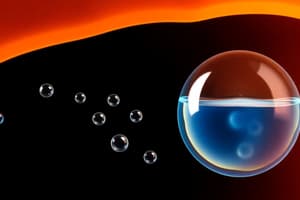Podcast
Questions and Answers
Which of the following best describes the primary difference between diffusion and osmosis?
Which of the following best describes the primary difference between diffusion and osmosis?
- Osmosis can occur with or without a partially permeable membrane, whereas diffusion always requires one.
- Osmosis involves the movement of solutes, while diffusion involves the movement of solvents.
- Diffusion requires energy input, while osmosis is a passive process.
- Diffusion involves the movement of any type of molecule, while osmosis exclusively involves the movement of water molecules. (correct)
A scientist observes that a cell in a solution swells up. What can the scientist conclude about the concentration of the solution relative to the cell's interior?
A scientist observes that a cell in a solution swells up. What can the scientist conclude about the concentration of the solution relative to the cell's interior?
- The solution has the same concentration of water as the cell's interior.
- The solution is in equilibrium with the cell's interior, so there is no net movement of water.
- The solution has a higher solute concentration than the cell's interior.
- The solution has a lower water concentration than the cell's interior. (correct)
In a system at equilibrium, what best describes the movement of particles?
In a system at equilibrium, what best describes the movement of particles?
- Particles continue to move, but there is no net change in concentration. (correct)
- Particles move from an area of low concentration to an area of high concentration.
- Particles cease to move entirely.
- There is no movement of particles in either direction.
Which of the following is NOT a characteristic of diffusion?
Which of the following is NOT a characteristic of diffusion?
A selectively permeable membrane separates two solutions. Side A has a 10% glucose solution, and Side B has a 20% glucose solution. Initially, water can move freely across the membrane, but glucose cannot. What will happen to the water level on each side?
A selectively permeable membrane separates two solutions. Side A has a 10% glucose solution, and Side B has a 20% glucose solution. Initially, water can move freely across the membrane, but glucose cannot. What will happen to the water level on each side?
Flashcards
What is Diffusion?
What is Diffusion?
Movement of particles from high to low concentration until evenly distributed.
What is Osmosis?
What is Osmosis?
Movement of water molecules from high to low water concentration across a partially permeable membrane.
What is a partially permeable membrane?
What is a partially permeable membrane?
A membrane that allows certain molecules to pass through but not others.
What is Equilibrium?
What is Equilibrium?
Signup and view all the flashcards
What is Concentration?
What is Concentration?
Signup and view all the flashcards
Study Notes
- Diffusion is the movement of particles from a place where there is a high concentration to an area where there is a low concentration.
- Particles move until they are evenly distributed.
Osmosis
- Osmosis is a special type of diffusion.
- It is the movement of water molecules.
- Water molecules move from an area of high water concentration to an area of low water concentration across a partially (selectively) permeable membrane.
- Equilibrium (equal distribution) is reached through this movement.
Studying That Suits You
Use AI to generate personalized quizzes and flashcards to suit your learning preferences.




